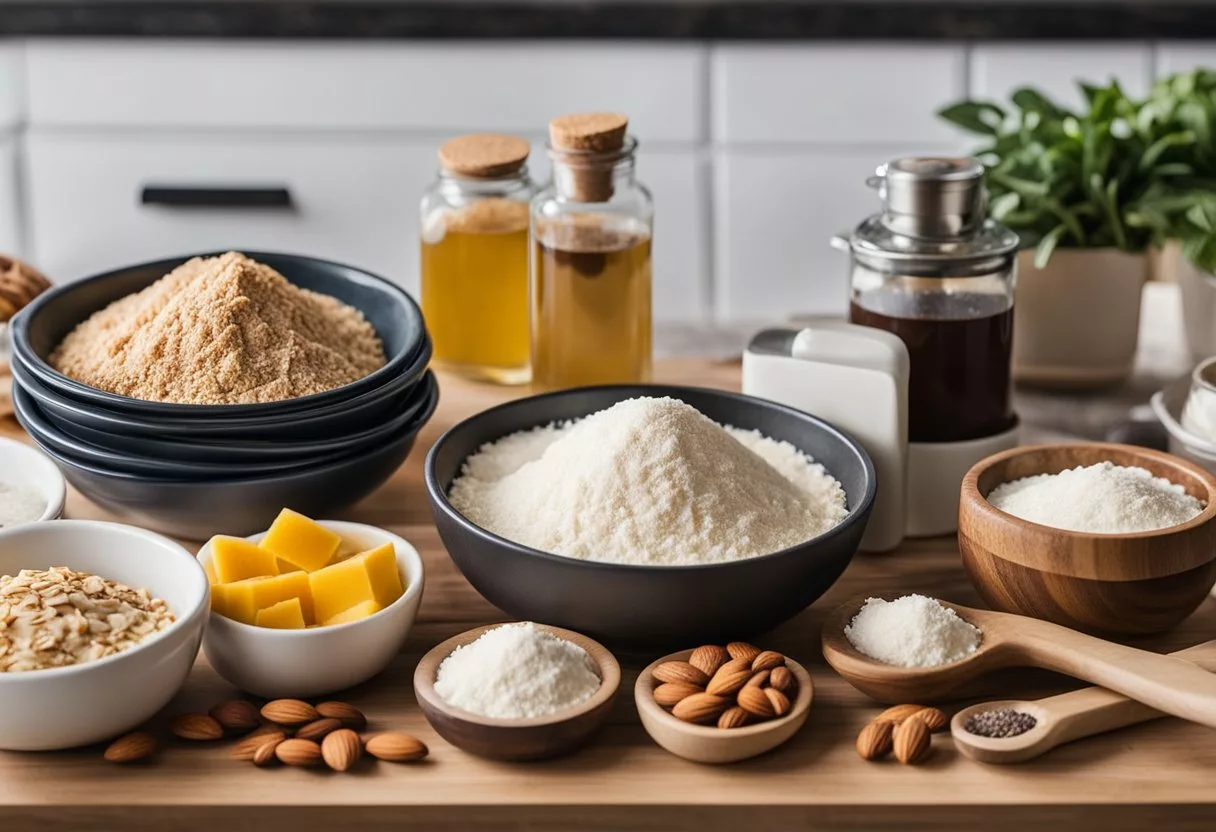Traditionally, the keto diet restricts sugary, high carb treats, which can often lead to cravings for sweet indulgences. However, this doesn’t mean those adhering to a keto lifestyle must forgo desserts altogether.
Advances in culinary creativity have given rise to keto-friendly desserts that satisfy sweet tooth cravings while still aligning with the dietary principles of ketosis.

Keto desserts leverage low-carb, high-fat ingredients to mimic the flavors and textures of traditional sweets. These alternatives often employ sweeteners like stevia or erythritol and use almond or coconut flour instead of conventional wheat flours to keep the carb count low. Fats such as butter, coconut oil, and cream are used both for their flavor and their role in maintaining the diet’s macronutrient ratios.
Accessibility to keto-friendly dessert recipes has increased, offering those on the diet a multitude of options ranging from cheesecakes to fat bombs and mousses, without derailing their nutritional goals.
Key Takeaways
- Keto-friendly desserts align with low-carb dietary goals while satisfying sweet cravings.
- Substitutions like low-carb flours and sugar-alternatives are essential in keto baking.
- A diverse range of indulgent keto dessert recipes is available for a variety of preferences.
Understanding the Keto Diet

The ketogenic diet focuses on high-fat, adequate-protein, and low-carbohydrate intake which shifts the body’s metabolism away from carbs and towards fat and ketones.
Ketosis and Net Carbs
Ketosis is a metabolic state achieved when the body uses ketones for energy instead of glucose from carbohydrates. To reach ketosis, individuals typically aim for a daily intake of 20-50 grams of net carbs, calculated by subtracting fiber from the total carbohydrates.
Benefits of a Low-Carb Lifestyle
A low-carb lifestyle may lead to weight loss, improved energy levels, and a reduction in blood sugar fluctuations. It’s important to consult with healthcare providers before starting a ketogenic diet to ensure it’s a safe option.
Ingredients to Embrace and Avoid
Those following a keto diet should embrace foods high in healthy fats like avocados and nuts, while avoiding high-carb staples such as bread and pasta. Instead of traditional flours and sugars, one can use almond flour or coconut flour and sweeteners like stevia or monk fruit.
Keto Sweeteners and Flours
Popular keto-friendly sweeteners include:
- Stevia: A natural, zero-calorie sweetener derived from the leaves of the Stevia plant.
- Monk fruit: A natural sweetener that contains no calories and is much sweeter than sugar.
In baking, traditional flour can be replaced with:
- Almond flour: Ground almonds, providing a gluten-free and low-carb alternative.
- Coconut flour: Made from dried coconut meat, it’s high in fiber, protein, and fat.
Fats and Oils on Keto
Healthy fats and oils are cornerstones of the keto diet. They include:
- Coconut oil: Rich in medium-chain triglycerides (MCTs), which are fats that can boost ketone production.
- Butter: Preferably from grass-fed sources, containing higher levels of omega-3 fatty acids.
Creating Balanced Keto Meals
A balanced keto meal often consists of a portion of protein, a variety of low-carb vegetables, and a generous serving of healthy fats. Keto breakfast options might include an omelet with cheese and spinach sautéed in butter. For desserts, sugar-free treats made with keto-friendly flours and sweeteners cater to sweet cravings without breaking the carbohydrate threshold.
Key Elements of Keto Desserts

The crucial components of creating keto desserts involve selecting the right sugar substitutes, prioritizing low-carb ingredients, and finding ways to satisfy cravings without derailing a ketogenic lifestyle. These desserts must carefully balance flavor and dietary requirements.
Understanding Sugar Alternatives
When preparing keto desserts, one must choose sweeteners that have a minimal impact on blood glucose levels. Sugar alcohols like erythritol and xylitol are common choices as they possess sweetness close to that of sugar without the same carbohydrate content. Other options include:
- Stevia: A plant-based sweetener with zero calories.
- Monk Fruit: Known for being much sweeter than sugar yet non-glycemic.
Importance of Low-Carb Ingredients
Keto desserts are predominantly made from ingredients that keep the overall carbohydrate count low. These typically include:
- Almond flour or coconut flour instead of traditional grain flours.
- Healthy fats like avocado or coconut oil.
- Fats from nuts and seeds for added texture and nutritional value.
Protein enrichment is sometimes achieved using protein powder, enhancing both the dessert’s nutritional profile and its ability to satiate.
Managing Sweet Tooth Cravings
It’s essential for individuals following a ketogenic diet to have dessert options that enable them to satisfy their sweet tooth without consuming high-carb ingredients. Keto desserts provide this balance, enabling enjoyment of sweet treats like cheesecake or chocolate mousse that are prepared with sugar-free components. Such desserts typically rely on the previously mentioned sugar alternatives and are designed to be indulgent yet compliant with keto dietary goals.
Keto Dessert Recipes

Embracing a ketogenic lifestyle does not mean giving up on desserts. This section explores a variety of indulgent keto-friendly sweets, from creamy cheesecakes to decadent chocolate treats and refreshing frozen desserts, all designed to satisfy cravings without compromising your dietary goals.
Keto Cheesecake Varieties
Keto cheesecake recipes offer the rich, creamy texture of traditional cheesecake with low-carb substitutes. Chocolate Cheesecake and Peanut Butter Cheesecake innovate on the classic with keto-friendly sweeteners and almond flour crusts. Recipes typically replace sugar with alternatives like erythritol, and high-fat cream cheese remains a staple.
Cookies and Brownies
Keto dessert repertoire includes Brownies and Cookies for those with a penchant for baked goods. A variety of recipes for Keto Brownies showcase fudgy textures achieved using almond or coconut flour. Keto Cookies range from classic Chocolate Chip to Peanut Butter, all crafted to keep carbs in check.
Keto Chocolate Delights
Chocolate lovers rejoice with Keto Chocolate Cake, Keto Chocolate Mousse, and Keto Chocolate Chip Cookies in their arsenal. These delights feature low-carb flours and sugar substitutes alongside cocoa powder or sugar-free dark chocolate to deliver rich flavor.
Creamy and Frozen Keto Treats
Keto-friendly Ice Cream and Keto Whipped Cream provide creamy and cold satisfaction, often utilizing full-fat dairy or coconut milk as a base. Keto Pudding can be made with chia seeds or xanthan gum to achieve a thick texture without the carbs.
Cakes, Cupcakes, and Muffins
For celebrations or everyday treats, Keto Cakes and Cupcakes offer a festive option. Recipes include Birthday Cake, lemon-flavored cupcakes, and cinnamon-infused Keto Coffee Cake. Miniaturized delights such as Keto Cheesecake Cupcakes and low-carb Muffins provide portion-controlled satisfaction.
Specialty Keto Desserts
Unique creations like Keto Fudge, Keto Candy, and Keto Bark fill the niche for handheld sweets. Keto Lemon Bars and Keto No Bake Cookies cater to those who prefer zest and convenience. For a quick single-serve treat, Keto Mug Cake recipes are available, including flavors like pumpkin and chocolate.
Tips and Techniques for Keto Baking

When approaching keto baking, one must adopt a new set of rules to achieve the delicious, low-carb results desired. Flour and sugar substitutes, along with proper dairy choices, play a crucial role in texture and flavor.
Baking with Keto Flours
In keto baking, traditional wheat flours are replaced with alternatives such as almond flour and coconut flour because they are low in carbohydrates. These flours behave differently since they lack gluten, which gives dough its elasticity. Almond flour brings a rich, buttery flavor and is ideal for tender baked goods. Coconut flour is highly absorbent, requiring an increase in liquids like eggs or dairy to prevent dryness. To achieve the best results, one must understand that coconut flour cannot be substituted in a 1:1 ratio for almond flour due to its absorbency.
| Keto Flour | Characteristics | Typical Use |
|---|---|---|
| Almond flour | Rich flavor, tender texture | Cookies, cakes |
| Coconut flour | Highly absorbent, dry | Breads, muffins |
Achieving the Right Sweetness
To mimic the sweetness of sugar without the carbs, keto bakers turn to sweeteners like erythritol or stevia. These sweeteners can vary in sweetness intensity, so it’s advisable to start with smaller quantities and adjust to taste. When using cocoa powder in recipes, it may also buffer the sweetness, which requires careful balancing with the chosen sweetener. Additionally, incorporating a bit of vanilla extract can enhance the sweetness perception.
Keto-Friendly Dairy Options
Dairy adds richness and moisture to keto baked goods. Options like butter and cheese should be full-fat to align with the keto macronutrient profile. It’s essential to understand how various dairy products can influence the texture and flavor of your keto recipes. For instance, butter delivers a subtle, creamy taste, which complements the nutty notes of almond flour. Cheese, mainly cream cheese, is often used in recipes like keto cheesecake to provide a dense and creamy consistency.
Remember to be attentive to the unique properties and ratios of these substitutes to ensure successful keto baking outcomes.
Frequently Asked Questions

Within the ketogenic community, there are common inquiries about incorporating desserts into the diet. The following frequently asked questions address preparation, purchasing, and selection of keto-friendly desserts, aiming to keep you aligned with low-carb, high-fat dietary goals.
What are some easy to prepare no-bake keto desserts?
Individuals following a ketogenic lifestyle often seek no-bake dessert options like keto cheesecakes, chocolate fat bombs, and coconut bars. These desserts typically require a simple combination of keto-friendly sweeteners, nut flours, and high-fat ingredients like coconut oil or cream cheese.
Which store-bought desserts are safe for a keto diet?
When shopping for keto-compliant desserts, one should look for items labeled as low-carb or sugar-free. Some brands offer keto-friendly ice creams, chocolate bars, and snack cakes. Always check the nutritional information to ensure the product fits within your daily carbohydrate allowance.
Could you suggest keto dessert recipes that incorporate cream cheese?
Cream cheese is a staple in many keto dessert recipes due to its high-fat and low-carb content. Popular options include keto cheesecake, cream cheese frostings, and cream cheese pancakes. These recipes often use a keto-friendly sweetener, such as erythritol or stevia, to maintain the sweet taste without adding extra carbs.
How can I indulge my sweet tooth while staying true to a ketogenic lifestyle?
To satisfy sweet cravings on a ketogenic diet, individuals can enjoy desserts made with low-carb sweeteners like erythritol or monk fruit. Options include almond flour-based baked goods, dark chocolate with a high cocoa content, and desserts made with avocado, such as chocolate mousse.
Is it possible to find keto-compliant desserts at local stores?
Many local health food stores and supermarkets now carry a selection of keto-friendly desserts. These can include pre-packaged items like sugar-free gelatin, low-carb baked goods, and dark chocolate. Always inspect labels for hidden sugars and carb content.
Can consuming low-carb sugar-free desserts affect a keto diet for diabetics?
For diabetics on a keto diet, it is essential to choose desserts that do not impact blood sugar levels significantly. Sugar-free, low-carb desserts using sweeteners with a low glycemic index are preferred. Diabetics should consult healthcare providers before making dietary changes to ensure that desserts fit within their personalized diabetic meal plans.
